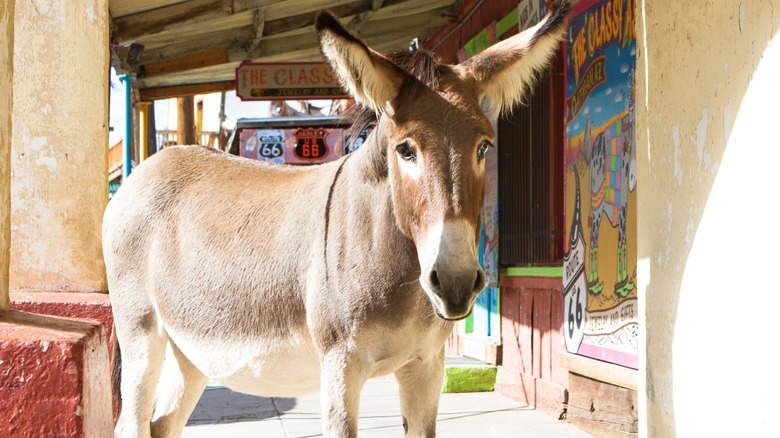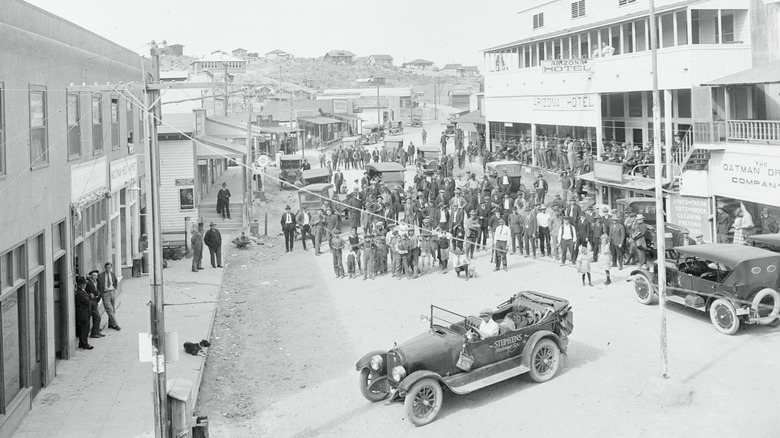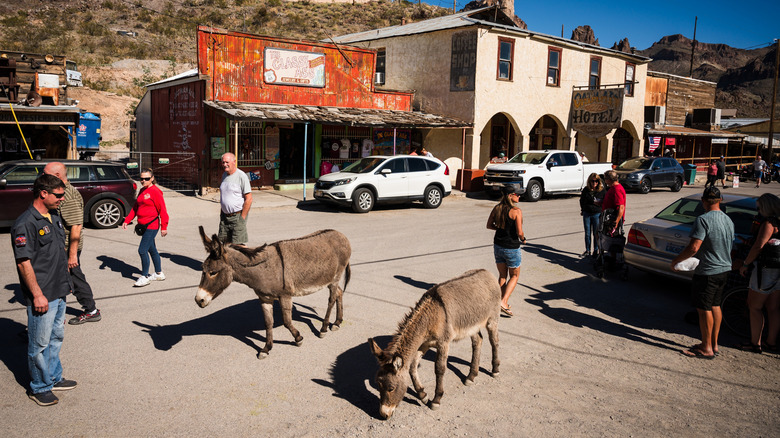Arizona's Quirkiest Town Must Be This Wild West Destination With Donkeys And Shootout Reenactments
Arizona has more than just a Grand Canyon. It is a land of beautiful English landmarks, delectable modern meaderies, vibrant indoor rainforests, and over 275 ghost towns. You may have heard of Jerome and Tombstone, two relics of the Old West that, through tourism, live on as semi-ghost towns with small resident populations rather than being completely deserted. Arizona's ghostliest towns include mining settlements such as Congress in Yavapai County and Gleeson in Cochise County, which faded into the desert when the mines shut in the 1930s.
Then there is Oatman, a former gold community about 30 miles southwest of Kingman. With just 103 residents, Oatman is one of the state's emptiest semi-ghost towns, considerably lonelier than Tombstone, which has 1,313 residents, or Jerome, with 459. Oatman's tiny population operate a thriving tourist industry centered around Old West architecture, staged shootouts, dozens of roaming burros, which are charming donkeys descended from the working animals that helped Oatman boom during its golden heyday.
Oatman, the gold rush town
In the early 1900s, when Arizona was still a territory, prospectors found gold in the Black Mountains and established the town of Oatman. Over the next 40 years, some 10,000 people lived in the mining town, producing over 1.8 million ounces of gold, worth some $4.8 billion in 2025 dollars. At its peak, Oatman had two banks, seven hotels, ten stores, and 20 saloons.
In the 1920s, Oatman became part of Route 66, the famous "mother road" running 2,400 miles from Chicago to Los Angeles. The iconic highway bolstered Oatman's economy for years, defending the town from the withdrawal of United Eastern Mines and other challenges. Despite this, Oatman's fortunes plummeted during the Second World War, when the government reallocated the town's miners to other pits that were more productive for the war effort. After the war, in 1952, authorities realigned Route 66 to bypass Oatman, addressing a hazardous stretch near the town but cementing its decline into ghostly desolation.
Oatman remained this way until the late 1980s, when Route 66 tourism from nearby Laughlin, Nevada, spread to the old mining town, attracting the biggest crowds since the mid-20th century.
Oatman the Old West tourist attraction
Today, Oatman consists of a short but dense Main Street with ruggedly handsome false front commercial buildings including Judy's Saloon, Jackass Junction gift shop, Mission Inn Antiques and Curios, and the Oatman Hotel Restaurant & Bar, which is a popular eatery with a full bar, hearty meals, but no rooms, despite the name. Wild burro donkeys roam Main Street in search of food and maybe a bit of attention. Feeding the donkeys is no longer permitted and the Bureau of Land Management may fine those who are caught, but a quick stroke or pat shouldn't be a problem.
Among Oatman's most popular customs are the twice-daily shootouts courtesy of the Oatman Ghost Rider Gunfighters, who gather an audience around them before a ruckus erupts and guns start firing. The performers use blank ammunition, of course, but it's still a loud and exciting show with plenty of winking, tongue-in-cheek machismo.
Aside from all the wild west fun, Oatman is surrounded by the Black Mountains' craggy peaks and ridges that afford awesome views over the town and the wider desert landscape in all its stark, massive beauty. If you are ready for a challenge, try the Boundary Cone hike, which may only be 1.5 miles long but involves a 1,289 ft climb. A five star All Trails review noted the route's difficulty but considered the strain worthy of the peak's awesome scenery.


